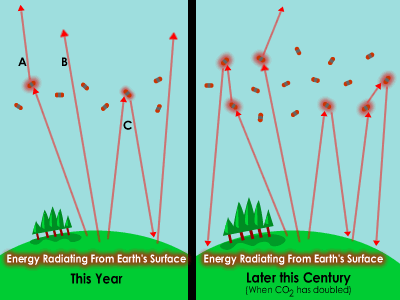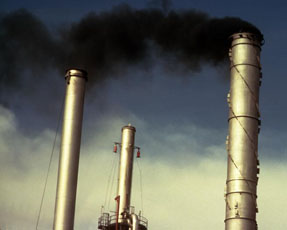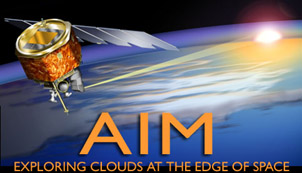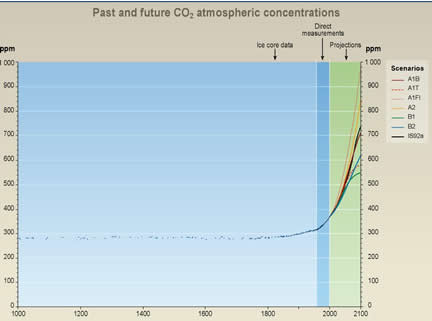This graph shows how the amount of carbon dioxide, a greenhouse gas in the Earth’s atmosphere, has changed over time and how it is expected to change in the future.
Click on image for full size
IPCC 2001 Third Assessment Report
The Changing Atmosphere Affects Earth's Climate
The molecules in Earth's atmosphere are always moving in and out of the air and changing through reactions. Even through the individual molecules are changing, the amounts of different elements within the atmosphere stays amazingly steady.
Even though the amount of most gases in the atmosphere is quite steady, scientists have found that the amount of greenhouse gases in Earth’s atmosphere has increased over the last 150 years. The rise in amount of greenhouse gases is directly related to human activities such as the burning of fossil fuels, deforestation, and curing of concrete. These activities are affecting Earth’s cycles such as the carbon cycle, the nitrogen cycle and the water cycle, influencing the planet as a whole.
Greenhouse gases trap heat through the greenhouse effect. There were greenhouse gases in the atmosphere long before humans affected the system. Having some greenhouse gases in Earth’s atmosphere is beneficial because they keep temperatures mild and suitable for life. However, as the amount of greenhouse gases has risen, so has Earth’s global temperature. This is causing changes to environments and ecologies around the world.
Last modified August 13, 2004 by Lisa Gardiner.
You might also be interested in:

An element (also called a "chemical element") is a substance made up entirely of atoms having the same atomic number; that is, all of the atoms have the same number of protons. Hydrogen, helium, oxygen,
...more
Even though only a tiny amount of the gases in Earth’s atmosphere are greenhouse gases, they have a huge effect on climate. There are several different types of greenhouse gases. The major ones are carbon
...more
Energy from the Sun that makes its way to the Earth’s surface can have trouble finding its way back out to space. This is because of a natural process called the greenhouse effect. Without the greenhouse
...more
Leaders from 192 countries are meeting in Copenhagen, Denmark December 7-18, 2009 to decide how the world will deal with climate change. They are trying to decide how to limit the amount of greenhouse
...more
The climate where you live is called regional climate. It is the average weather in a place over more than thirty years. To describe the regional climate of a place, people often tell what the temperatures
...more
Satellites that orbit Earth help us study Earth's atmosphere, weather, and climate. Here are a few of the many spacecraft that study our atmosphere. Aura was launched in July 2004. It is studying pollution,
...more
To figure out the future of climate change, scientists need tools to measure how Earth responds to change. Some of these tools are global climate models. Using models, scientists can better understand
...more















